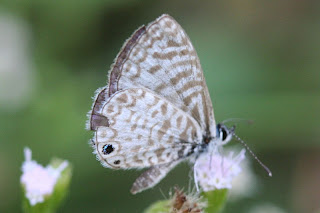What happened wasn't enough to call it an "incident" but that's the word that comes to mind. I will try to relate it.
This morning I went outside to draw the plumbago. I do this often and have been doing so for years. I'm still getting to know it and trying to understand the way it grows which is extremely odd and unusual. As I was drawing, a little butterfly came along, a very tiny one. It fluttered around the plumbago, stopping on a leaf now and then. Then it fluttered off elsewhere. A few minutes later it was back. I had seen it yesterday too and noted that it seemed to choose the plumbago over the other plants in the area, and that in some ways it resembled the plumbago flower just a little -- it was about the size of a single petal and pale-coloured with a hint of blue. So I put down the pencil and decided to observe it a while.
 |
| Drawing the plumbago and notes on a butterfly © Mary Adam |
It would flutter away over a taller bush and disappear from sight and then return a few minutes later. When it landed on the plumbago it didn't land on an open flower, instead it chose a leaf or a head of unopened small green buds. I don't think it was feeding but can't say for sure. At any rate, it seemed as if it was landing intentionally on the plumbago, that it wasn't just chance. After ten or fifteen minutes of coming and going, to my surprise a second one of the same kind came along. I was pretty sure now that it was no accident. They moved very quickly so it wasn't possible to get a good look, fluttering around and around, up and down, settling for a second or two and then off again.

Rain was threatening so I packed up and went inside and looked out the
Butterflies of Trinidad and Tobago by Malcolm Barcant (1970, Collins), with its wonderful colour plates. There wasn't much to go on except the small size, and when it closed its wings the undersides were pale beige with dark spots. Quite nondescript really, not easily identified like the Morpho. But Plate 9, No. 20 looked like it could be it --
Leptotes cassius? Also known as Meadow Blue, and belonging to the Lycaenid family. It's a common species says Barcant, "a common beauty ... lover of wide open spaces, abundant sunshine and low-growing ground shrubs with flowers." (p. 84).
Googling the name brought up lots more, it has its own entry in Wikipedia:
Leptotes cassius, commonly known as the Cassius Blue or Tropical Striped Blue, is a butterfly of the Lycaenidae family. It is found in Florida and the Keys, Texas south through the Caribbean, Mexico, and Central America to South America. Strays can be found in New Mexico, Kansas, Missouri and South Carolina. The wingspan is 20–35 mm. The butterfly species has an important role in Marisha Pessl's 2006 novel Special Topics in Calamity Physics. The protagonist, Blue van Meer, is named in honor of the Cassius Blue. The caterpillars feed natively on Fabaceae. Foodplants on record are Amorpha crenulata, Woolly Rattlepod (Crotalaria incana), Galactia regularis and Lima Bean (Phaseolus lunatus). It can also successfully develop feeding on Cape Leadwort (Plumbago auriculata) or Doctorbush (P. scandens), which (among the eudicots) are not closely related to its usual foodplants.[1] (Underlining added).
This last was a surprise as I've looked up Plumbago many times and have not previously seen it identified as a food plant for any butterfly. So that explained it ... the two butterflies were checking out the plumbago as a place to lay eggs where its caterpillars could feed. THE END. Sorry if it's a terrible anti-climax, the "incident of the butterfly" was a simple little occurrence that gave me pleasure and that I wanted to share.
.jpg) |
| Cassius Blue, image from Wikipedia |
Used copies of
the Malcolm Barcant book can be found on Amazon. And a refurbished butterfly room housing his collection was reopened at the House of Angostura in April this year (
Newsday, April 18, 2013). [
Newsday says, For more information or to book a tour, call 623-1841 ext 255 and 257.]





.jpg)